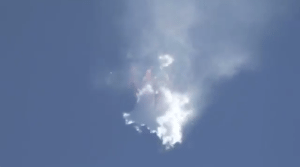Latest News
[Via Satellite 06-29-2015] SpaceX is spearheading the investigation of a launch anomaly after the June 28 Commercial Resupply Services 7 (CRS-7) mission failed 139 seconds into flight. The Falcon 9 rocket used for the NASA cargo mission was to deliver more than 4,000-lbs of supplies including food, water, research equipment, scientific experiments and small satellites to the International Space Station (ISS).
Shortly following this incident, SpaceX Founder and CEO Elon Musk tweeted “there was an overpressure event in the upper stage liquid oxygen tank,” adding that “data suggests counterintuitive cause.” In a press conference approximately three hours after the 10:21 A.M. Eastern Time launch failure, SpaceX President and COO Gwynne Shotwell shared more details about the company’s preliminary findings.
“What I can tell you at this point is the first stage flight remained nominal. We do not expect this to have been a first stage issue. We saw some pressurization indications in the second stage, which we’ll be tracking down and following up on there,” she said.
The June 28 mission was the 19th launch of the Falcon 9 rocket, which has captured a significant amount of business in the commercial launch sector. CRS 7 was the seventh mission for NASA as part of the CRS contract that began in 2008. The launch anomaly grounds future missions with the Falcon 9 while SpaceX conducts its review.
The Falcon 9 launch failure adds to a string of high profile launch woes over the past 12 months for both the United States and Russia. In October 2014, an Orbital Sciences, now Orbital ATK, Antares rocket exploded seconds after liftoff, destroying more than 2,000-lbs of cargo within the Cygnus spacecraft and damaging launch infrastructure at Wallops Island, Va. In April this year Russia’s Progress M 27M vessel detached irregularly from the third stage of its Soyuz 2.1a carrier rocket, spinning out of control before burning up in the atmosphere. And in May an International Launch Services (ILS) Proton mission carrying the Centenario satellite for Mexico’s Ministry of Communications and Transportation (SCT) failed 490 seconds after liftoff. These events have sidelined two primary launch vehicles for the satellite industry — Proton and the Falcon 9 — and with both the Falcon 9 and Antares out of commission NASA’s two commercial resupply partners are for the time being also grounded.
“We expected through the Commercial Crew Program (CCP) we would lose some vehicles. I didn’t think we would lose them all in a one year time frame, but we have,” William Gerstenmaier, associate administrator for human exploration and operations, said during the NASA press conference.
The next mission to the ISS is the Russian Progress M 28M on July 3. Gerstenmaier said the ISS remains in good shape to stay manned, despite the launch failures. The following missions, he said, are Mitsubishi Heavy Industries and the Japanese Aerospace Exploration Agency’s (JAXA’s) HTV5 aboard the H-2B rocket, and Orbital ATK’s Cygnus aboard a United Launch Alliance (ULA) Atlas 5 rocket. Following the Antares failure, then Orbital Sciences purchased an Atlas 5 to use in lieu of its own vehicle, with an option for a second mission, while simultaneously pursuing its own investigation and accelerating its shift away from Aerojet Rocketdyne’s AJ-26 engines. The re-engined Antares will use the RD-181 from Russia’s NPO Energomash — the same manufacturer of the RD-180 currently used to power the Atlas 5.
Pam Underwood, deputy division manager of the U.S. Federal Aviation Administration (FAA) operations integration division said during the press conference that the Falcon 9 anomaly is classified as a mishap, meaning SpaceX will conduct the investigation with FAA oversight. Shotwell said vehicles in place for what was intended to be the third recovery attempt of the rocket’s first stage had been repurposed with searching for debris. Any remnants that can be retrieved could aid in the investigation of the cause. SpaceX continued to receive telemetry as well from the Dragon spacecraft after the event, and Shotwell said the company would monitor all the data it collects to identify the issue, resolve it and return the Falcon 9 to flight.
“We’ve got over three thousand telemetry channels to look at for data, including video, so if there is something there we will find it. We are going to look at everything,” she said.
Shotwell confirmed that there was nothing particularly different the rocket used for the CRS-7 mission. She estimated that the time to return to flight would certainly be less than a year, but declined to speculate further. Shotwell suggested that SpaceX’s vertically integrated approach to building the Falcon 9 would be beneficial in identifying the cause of the flubbed launch.
“The majority of this launch vehicle and all its components are ours, so we don’t have to go through legal and conjugal and contracts and negotiations and discussions to get data on any components. We own it all. I’m sure we’ll find it rapidly, and we’ll get back to flight as soon as we safely and reliably can,” she said.
Gerstenmaier said NASA could look to work with Orbital ATK and ULA on shifting the Atlas-Cygnus launch up to October. He emphasized that SpaceX and the ISS teams worked “extremely well” despite the setback, and that the teams will work through these challenges effectively in order to return to flight.
“The important thing is we stand down just long enough to understand the failure, to internalize the learning and move forward,” he said.
Other upcoming launches in SpaceX’s manifest include the Jason 3 weather satellite for NOAA, the French Space Agency (CNES), European Organization for the Exploitation of Meteorological Satellites (EUMETSAT), and NASA, SES 9 for SES, and the remaining 11 Orbcomm Second Generation (OG2) satellites. In a June 29 tweet, Musk stated that the anomaly’s cause remains unknown “after several thousand engineering-hours of review,” and that SpaceX is “now parsing data with a hex editor to recover [the] final milliseconds.”
Get the latest Via Satellite news!
Subscribe Now